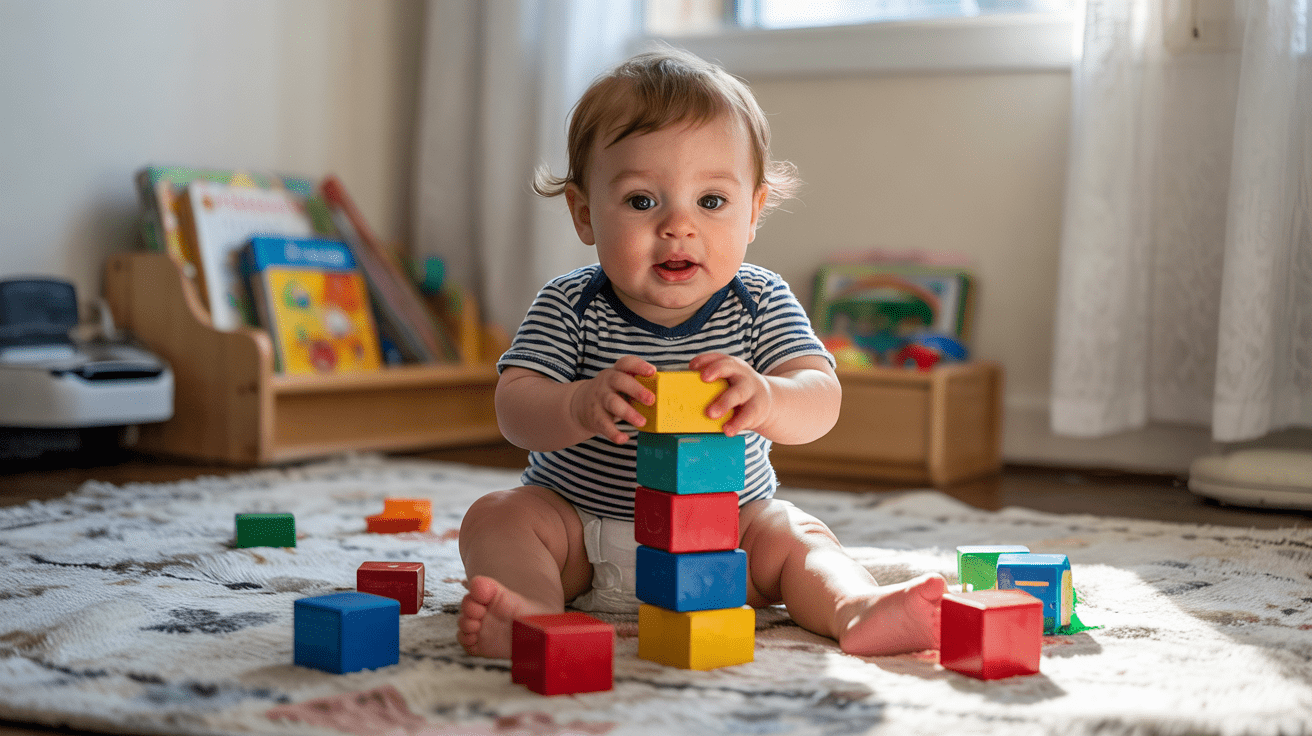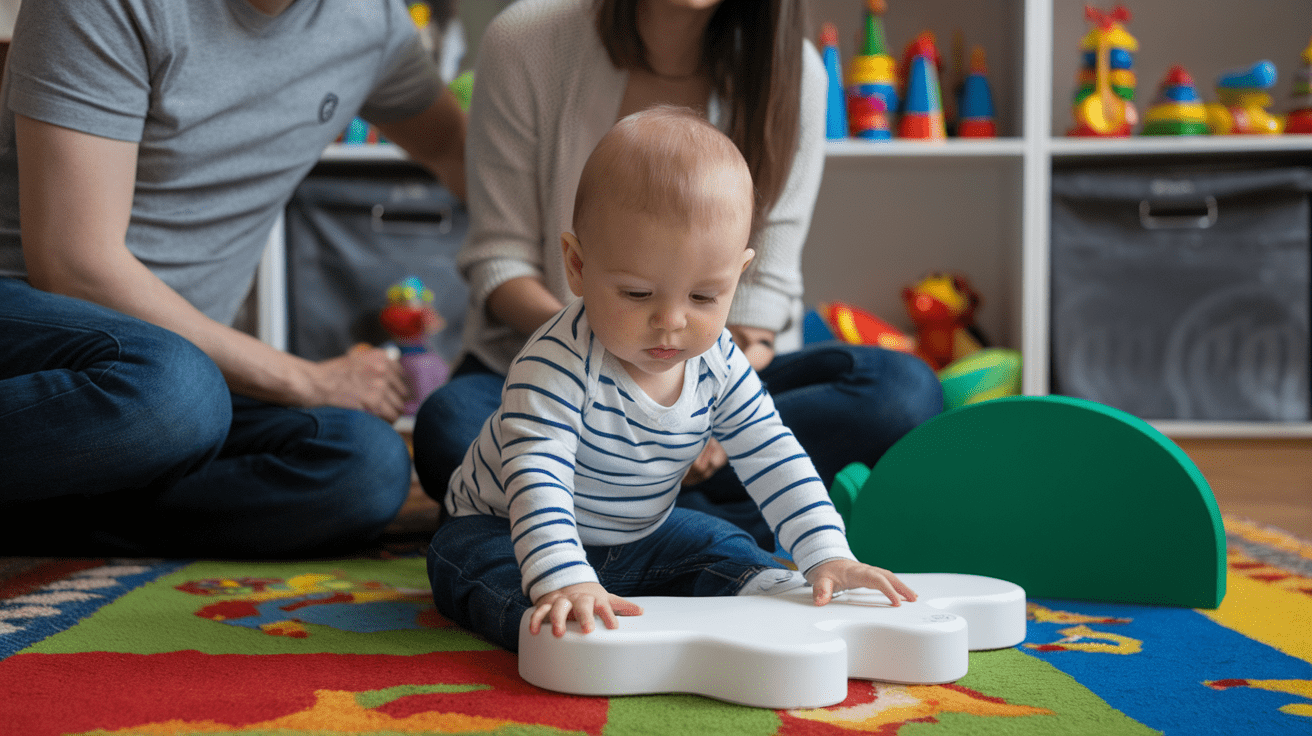
Ever wondered why your peacefully sleeping baby suddenly turns into a fussy, hungry little being overnight? You’re not alone!
Your baby’s first year is a rollercoaster of remarkable changes, from growth spurts that rapidly increase their physical size to developmental leaps that unlock new cognitive abilities.
While growth spurts primarily affect your baby’s body, triggering increased hunger and visible physical changes, developmental leaps change how your baby experiences and interacts with the world around them.
Understanding these predictable patterns helps you anticipate your baby’s changing needs, distinguish between normal developmental phases and potential concerns, and maintain your sanity during challenging periods.
Join us as we decode these mysterious transitions and learn how to support your little one through each exciting stage of development!
What Are Growth Spurts?
Growth spurts are intense periods of rapid physical development when your baby experiences accelerated growth in a short timeframe.
Biologically, they occur when your baby’s body releases growth hormones that trigger cell multiplication and bone elongation. During growth spurts, you may notice your baby suddenly outgrowing clothes, gaining weight, or appearing longer.
Their hands and feet might seem bigger, and their body proportions may temporarily look different. Some babies develop chubbier cheeks or thighs during these phases.
Nutritionally, babies require significantly more calories during growth spurts. Breastfed babies typically cluster feed or nurse more frequently, while formula-fed babies may finish bottles faster or demand additional ounces.
This increased hunger directly fuels their rapid physical development, providing the essential proteins, fats, and nutrients needed to support new tissue growth and bone development.
Common Baby Growth Spurt Timelines

Growth spurts are short periods when a baby’s body goes through rapid changes in size, weight, and development. While each baby grows at their own pace, most follow a general pattern in their first year.
| Age | Growth Spurt Highlights |
|---|---|
| 2–3 weeks | First noticeable growth: baby may feed more and sleep less |
| 6 weeks | More alertness; possible fussiness and increased feeding |
| 3 months | Major physical development: Limbs and head control improve |
| 6 months | Growth tied to solid food introduction and sitting up |
| 9 months | Often aligns with crawling and pulling up to stand |
Not all babies follow the same timeline. Some may grow in short bursts more often, while others may grow steadily or hit big milestones suddenly.
Premature babies may follow an adjusted schedule based on their due date. Watch your baby’s behavior and development for clues rather than relying solely on age-based charts.
Signs Your Baby Is Experiencing a Growth Spurt

Growth spurts can sometimes feel like they come out of nowhere, but your baby will typically show several clear indicators. Recognizing these signs can help you respond appropriately to your baby’s changing needs.
1. Increased Hunger and Feeding Frequency
One of the most noticeable signs is a sudden increase in appetite. Your baby may want to feed more frequently or consume larger amounts during each feeding.
Breastfed babies often cluster feed (nurse in close succession), while formula-fed babies might finish bottles faster or seem unsatisfied with their usual amount.
2. Sleep Pattern Changes
During growth spurts, some babies sleep more to conserve energy for growing, while others experience disrupted sleep. You might notice your previously good sleeper waking more frequently at night or taking shorter naps.
Alternatively, some babies become extra sleepy and need additional rest to fuel their development.
3. Fussiness and Clinginess
Growth spurts often bring temporary behavior changes. Your baby might become more irritable, fussy, or difficult to comfort. Many babies also become clingier during these periods, wanting more cuddles and reassurance.
This can be their way of processing the unfamiliar sensations they’re experiencing in their rapidly changing bodies.
4. Physical Signs of Growth
The most definitive evidence is in the physical changes themselves. You might suddenly notice that sleepers and onesies feel snug or that pants that fit last week now seem too short.
Some babies also show temporary changes in body proportions, with limbs sometimes appearing longer overnight. Weight gain, often visible in chubbier cheeks or thighs, frequently accompanies these growth periods.
What Are Developmental Leaps?

Developmental leaps, popularized by the Wonder Weeks theory, refer to predictable periods when babies make significant cognitive advancements.
These mental growth spurts occur as your baby’s brain forms new neural connections, allowing them to perceive and interact with the world in more complex ways.
Unlike physical growth spurts that primarily affect body size and hunger, developmental leaps change how your baby processes information.
During these periods, babies acquire new mental skills, such as recognizing patterns, understanding spatial relationships, and developing social awareness.
Brain development during leaps is remarkable. Your baby’s brain undergoes rapid reorganization as neurons form new pathways, creating the foundation for future skills.
This neural restructuring explains why babies often seem fussier or more clingy during leaps—they’re literally experiencing the world differently as their brains work overtime to integrate new perceptual abilities.
The Major Mental Leaps in the First Year

Babies go through around eight mental leaps in their first year, with each leap unlocking new ways of thinking and understanding the world.
These leaps can temporarily affect sleep, mood, and feeding, but they mark exciting progress in your baby’s cognitive development.
| AGE | LEAP | KEY DEVELOPMENTS |
|---|---|---|
| 5 weeks | Leap 1: Sensations | Begins noticing patterns, tracks objects, and responds to new sensations |
| 8 weeks | Leap 2: Patterns | Increased focus on contrasts and smooth movements |
| 12 weeks | Leap 3: Transitions | Starts understanding cause and effect |
| 19 weeks | Leap 4: Events | Improved hand-eye coordination, awareness of event sequences |
| 26 weeks | Leap 5: Relationships | Early grasp of spatial concepts and object permanence |
Your baby may become fussier, eat differently, or wake up more at night. These behaviors are signs that big developmental changes are just around the corner. Keep routines steady and offer extra comfort—your baby is growing in amazing ways!
How Long Do Leaps and Growth Spurts Last?

Growth spurts typically last between 2 and 7 days, and most babies experience intense hunger and physical changes for about 3 days.
During this brief but demanding period, your baby’s body works overtime to achieve significant physical development.
Developmental leaps, by contrast, tend to be longer processes. Each leap typically lasts 1-5 weeks from start to finish, with the most challenging behaviors usually occurring during the first 1-2 weeks. The duration varies based on both the specific leap and your baby’s development pace.
Fortunately, the most intense symptoms don’t last forever. For growth spurts, feeding patterns typically normalize within a week. With developmental leaps, fussiness and sleep disruptions gradually decrease as your baby masters new skills.
By understanding these timeframes, parents can find reassurance that challenging phases are temporary and signal important developmental progress.
How to Support Your Baby

Supporting your baby through growth spurts and developmental leaps means meeting their changing needs with patience, comfort, and consistency. Small adjustments in care can make a big difference during these phases.
1. Feeding Adjustments
Growth Spurts: During growth spurts, feed based on hunger cues, not the clock. Babies may need to eat every 1–2 hours. Breastfeeding moms may nurse more often, while formula-fed babies might need larger or more frequent bottles. Stay hydrated and well-nourished to support your baby’s growth.
Developmental Leaps: Feeding during leaps can be challenging, as babies may be too distracted or fussy to eat well. Minimize stimulation to create a calm feeding environment. Consider shorter, more frequent feedings if your baby seems overwhelmed.
2. Managing Increased Needs
Growth Spurts: Prepare for increased hunger by keeping extra milk or formula on hand. Breastfeeding moms can pump for backup. Older babies may want more solids, so offer nutrient-rich options while maintaining balanced nutrition.
Developmental Leaps: During leaps, babies need extra emotional support. Respond to their cues with comfort and physical contact. Create a safe “yes space” and offer age-appropriate toys that match their developmental stage.
3. Comfort Measures
Growth Spurts: Physical comfort matters during growth spurts. Dress babies in soft, loose clothes and offer extra cuddles, massages, or warm baths to ease discomfort. Babywearing can soothe your baby while keeping your hands free.
Developmental Leaps: Stick to predictable routines, even if your baby resists. Familiar patterns offer comfort during mental leaps. Keep the environment calm and low-stimulation during fussy times. Clinginess and crying are normal—your steady presence is the best support.
Sleep Changes During Growth and Development

Baby sleep patterns often fluctuate significantly during both physical growth spurts and developmental leaps.
During growth spurts, many babies sleep more heavily or for longer periods as their bodies direct energy toward physical development. However, some may wake more frequently due to increased hunger needs.
Developmental leaps frequently trigger sleep regressions as babies process new cognitive abilities. Their brains remain active during sleep, working to integrate new skills, which can cause more night-waking, shorter naps, and increased difficulty settling.
To manage these disruptions, maintain consistent bedtime routines even when they seem ineffective. Consider temporarily adjusting schedules to accommodate increased sleep needs or more frequent feedings.
Practice responsive settling techniques without creating new sleep dependencies.
Remember that most sleep disruptions during these periods are temporary and typically resolve once the growth spurt or developmental leap completes.
Self-Care for Parents During Challenging Periods

Handling growth spurts and developmental leaps can be exhausting for parents.
To cope with increased demands, prioritize essential tasks and let go of perfection during these temporary phases. Connect with other parents experiencing similar challenges to create reliable support systems.
Don’t hesitate to ask partners, family members, or friends for specific help with meals, household tasks, or childcare breaks.
Manage stress by incorporating micro-moments of self-care—even five minutes of deep breathing, a quick shower, or stepping outside can reset your patience.
Stay nourished with easy-to-eat foods, hydrate consistently, and rest whenever possible, even if full sleep isn’t achievable. Remember that taking care of yourself is taking care of your baby.
Final Thoughts
As your baby goes through growth spurts and developmental leaps in their first year, remember that even the most challenging phases are temporary.
Those sleepless nights, cluster feeding sessions, and fussy periods will pass, leaving behind a more skilled, capable little person.
While it’s natural to look forward to easier days, try to appreciate each stage for its unique wonders. The same developmental leaps that cause temporary disruption are creating the foundation for your child’s future abilities and independence.
Beyond the first year, your toddler will continue experiencing growth and developmental advances, though typically with less intensity and more predictable patterns.
The understanding you’ve gained during this first year will serve as valuable preparation for navigating future milestones with confidence, patience, and joy.
Your baby’s growth progress is just beginning!
If you’re interested in more informational content on mothers and babies, feel free toclick here and explore other blogs that you might enjoy.
